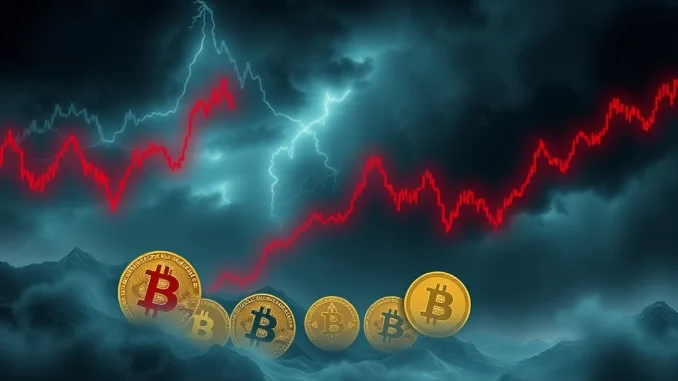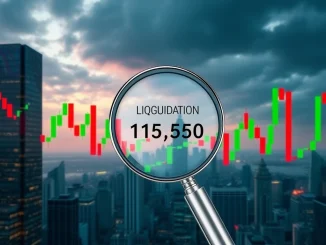
Are you feeling uneasy about the recent dips in the crypto market? You’re not alone. A critical indicator in traditional finance is flashing red, and it could spell further turbulence for Bitcoin and the broader cryptocurrency landscape. CoinDesk recently reported that credit spreads have surged to levels not seen since August 2024. Historically, such spikes have preceded downturns in riskier assets. So, what exactly does this mean for your crypto portfolio, and should you be bracing for a potential drop? Let’s dive into the details and explore what’s happening.
Decoding Credit Spreads: What Are They and Why Should Crypto Investors Care?
First things first, let’s break down what credit spreads are in simple terms. Imagine you want to borrow money. Lenders assess the risk of you not paying them back. Credit spreads are essentially the difference in yield between corporate bonds (considered riskier) and safer government bonds (like US Treasuries). A widening spread indicates that investors perceive higher risk in corporate debt. This heightened risk perception often bleeds into other asset classes, particularly those considered ‘risk-on,’ such as cryptocurrencies and stocks.
Here’s a simplified breakdown:
- Credit Spreads Defined: The gap in yield between corporate bonds and government bonds.
- Rising Spreads = Rising Risk Perception: When credit spreads increase, it signals that investors are becoming more concerned about the financial health of companies and the overall economy.
- Risk-Off Sentiment: This increased risk aversion typically leads investors to pull back from riskier investments like Bitcoin and other cryptocurrencies in favor of safer havens.
Think of it like this: when the financial weather forecast turns stormy (rising credit spreads), investors tend to seek shelter (safer assets), leaving the more volatile assets like crypto exposed to potential price drops.
The Historical Connection: Credit Spreads and Risk Asset Performance
The relationship between credit spreads and risk assets isn’t just theoretical; it’s backed by historical data. Sharp increases in credit spreads have often been a precursor to declines in assets like stocks and, more recently, cryptocurrencies. Why is this the case?
When credit spreads widen rapidly, it suggests a few things:
- Increased Borrowing Costs: Higher spreads mean it becomes more expensive for companies to borrow money. This can squeeze corporate profits and lead to economic slowdowns.
- Liquidity Concerns: Widening spreads can also indicate tightening liquidity in the financial system. Investors become less willing to lend, and markets can become more volatile.
- Economic Uncertainty: Ultimately, rising credit spreads reflect a growing sense of uncertainty about the future economic outlook. This uncertainty makes investors nervous about holding onto riskier investments.
Historically, during periods of heightened financial market stress reflected by spiking credit spreads, we’ve seen investors reduce their exposure to risk assets. Bitcoin, despite its growing adoption, is still largely considered a risk-on asset. Therefore, when traditional financial indicators like credit spreads flash warning signs, the crypto market often reacts negatively.
Bitcoin’s Vulnerability: Why Crypto Could Face Downward Pressure
While Bitcoin has matured significantly as an asset class, it’s still not immune to macroeconomic headwinds. In fact, its relatively high volatility makes it particularly susceptible to shifts in investor sentiment driven by factors like rising credit spreads. Here’s why this is a concern for the crypto market:
- Correlation with Risk Sentiment: Bitcoin and many other cryptocurrencies tend to exhibit a positive correlation with broader market risk sentiment. When investors are feeling risk-averse, crypto often suffers.
- Liquidity Drain: In times of financial market stress, investors may liquidate more volatile assets like crypto to raise cash or move into safer investments. This can create downward pressure on crypto prices.
- Institutional Investor Behavior: Even institutional investors, who are increasingly entering the crypto space, are likely to react to traditional financial signals like credit spreads. If these signals suggest increased risk, institutions might reduce their crypto allocations.
Therefore, the current rise in credit spreads is not just a traditional finance concern; it’s a significant signal for the crypto market, suggesting potential downward pressure on Bitcoin and other digital assets.
Navigating the Uncertainty: What Should Crypto Investors Do?
So, what actionable insights can crypto investors glean from this situation? Should you panic and sell all your crypto holdings? Not necessarily. However, it’s crucial to be aware of the risks and take a measured approach.
Here are some steps to consider:
- Stay Informed: Keep a close eye on credit spreads and broader economic indicators. Financial news outlets and analytical platforms regularly provide updates on these metrics.
- Assess Your Risk Tolerance: Understand your own comfort level with volatility. If you’re risk-averse, consider reducing your exposure to risk assets, including crypto, during periods of heightened uncertainty.
- Diversify Your Portfolio: Don’t put all your eggs in one basket. Diversification across different asset classes, including less volatile options, can help mitigate risk.
- Consider Dollar-Cost Averaging (DCA): Instead of trying to time the market, consider using a DCA strategy to gradually buy or sell crypto over time. This can help smooth out volatility.
- Long-Term Perspective: Remember that the crypto market is inherently volatile. Focus on the long-term potential of the technology and projects you believe in, rather than getting overly fixated on short-term market fluctuations.
The Million-Dollar Question: Will Credit Spreads Keep Rising?
The crucial question now is whether credit spreads will continue their upward trajectory. If they do, it would indicate sustained or increasing financial market stress, likely leading to further challenges for risk-oriented investments like Bitcoin. Several factors could influence the direction of credit spreads, including:
- Inflation and Interest Rates: Continued high inflation and further interest rate hikes by central banks could exacerbate economic concerns and widen credit spreads.
- Geopolitical Events: Unexpected geopolitical events can also trigger risk aversion and lead to spikes in credit spreads.
- Corporate Earnings: If corporate earnings start to decline, it could signal weakening economic conditions and further widen spreads.
Monitoring these factors will be key to understanding the future trajectory of credit spreads and their potential impact on the crypto market.
In Conclusion: Heed the Warning Signs, But Don’t Panic
Rising credit spreads are indeed a warning sign for Bitcoin and other risk assets. They reflect growing concerns about economic health and financial market stress, which historically have preceded downturns in riskier markets. While this situation warrants caution and careful portfolio management, it doesn’t necessarily mean a catastrophic crash is imminent. By staying informed, understanding your risk tolerance, and taking a balanced approach, you can navigate this period of uncertainty in the crypto market effectively. The key takeaway? Be aware, be prepared, and don’t let fear drive your investment decisions.



